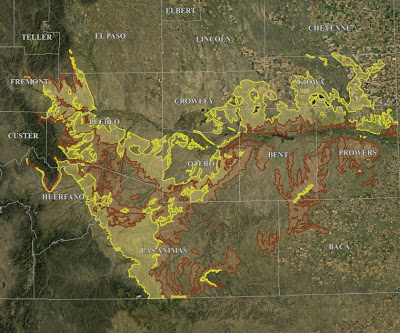From Cañon City in southeastern Colorado to the Kansas and New Mexico borders lies an area of marine rocks dating back to the Cretaceous, exposed by the inexorable erosional processes of the Arkansas River. These exposed shales and soft limestones (chalk) form outcrops of an interesting and important habitat type – shale barrens.

call them lush with vegetation, either.
Photo by Renée Rondeau
CNHP ecologist Renée Rondeau has been documenting these habitats in Las Animas, Pueblo, and Huerfano Counties this past summer. These habitats are extremely vulnerable to surface disturbance such as mining, quarrying, and other activities that lead to changes in soil structure or vegetation structure.

Photo by Renée Rondeau
The area between Pueblo and Cañon City contains the highest frequency of such shale barrens in southeastern Colorado. Forming low hills above the surrounding shortgrass prairie, the barrens typically have a high percentage of open, rocky ground and sporadic vegetation. Some occurrences have an overstory of sparse juniper and/or pinyon pine, and may include scattered larger shrubs and bunchgrasses. Shale substrates often form a rocky “pavement” between plants.

Photo by Renée Rondeau
A number of Colorado’s rare plant species are found on shale barrens, especially on substrates formed from the Smoky Hills Member of the Niobrara Formation. Some may also occur on the Fort Hayes member of the Niobrara, or occasionally on substrates derived from adjacent Cretaceous formations such as the Carlile Shale, Greenhorn Limestone, and Graneros Shale.

Greenhorn Limestone, and Graneros Shale formations (brown) in southeast Colorado.




